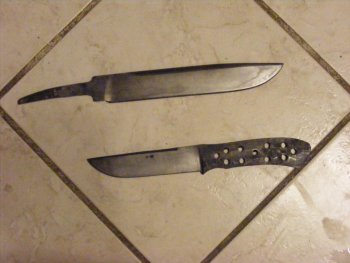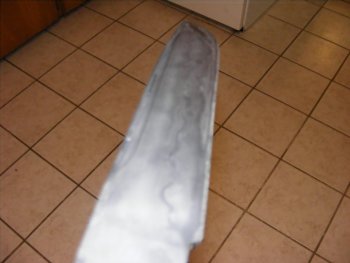well mccllelan im only an 400 grit paper right now but i think it will work in the end. oh hey how do you guy check hardness? and what do you do for cutting test? these hamons are realy starting to give me head aches...

Badger,
If your head is starting to hurt you're rubbing with the wrong part of your body! Kidding aside, it's usually my elbows or back depending how I'm standing, but pain is a part of knife making depending on how old you are!
I have spent upwards of 30 hours+ handsanding trying to get a hamon to POP! Sometimes it works sometimes it doesn't, once you've finished polishing after your first etch, you may need to repeat starting at around 180 grit back to 400, then re-etch, and re-polish, also sanding to a much higher grit will make it a lot nicer, somewhere around a 1000 grit, that sometimes does wonders, Hamons are finickier than CATS! And yes they will drive you CRAZY, In the words of one of my favorite makers, Don Hanson, when I was asking for help, after a similar statement, he said, " Fun, aint it!"
If you were closer I would be happy to have you over to my shop and I could show you exactley how I do it, just like I was shown, it took that kind of one on one for the light to come on in my head! Have you looked at Stephen Fowler's tutorial? It's almost the same way I do mine, and he gets great hamons! I think he advises at least three cycles of sanding, etching and polishing. The higher grit will help, but you have to relize that some times it's not going to happen, you should be able to see some sort of line around 400 without etching if it is a really good one, etching will bring it out more.
For cutting test, remember it depends on the type of knife as well, with some choppers and hunters I start off with news paper, if it can cut that with out making it bunch up, edge gemetry should be pretty close, for toughness (with choppers) I have some seasoned oak, I take several chops on it, after a few cuts I'll inspect the edge for any deformity, if there is none, it should be in good shape, but I keep chopping making sure I hit every part of the edge, my seasoned oak is about 5 years old, so it's pretty hard, for my bigger choppers with thicker edges I have some Mock Orange, I use sometimes when I'm feeling confident, or suspect that it didn't harden correctly, that stuff will destroy an un-hardened or thin edge, not for everyone, its like chopping steel! I have heard of folks chopping 10 penny nails, brass rods etc. Then I do some stabbing into the oak and twist the blade out fast and slow, to watch to see how much the blade is going to twist some or none, I want it to give some without deformity, it should spring back. Most of these tests are for larger knives, a smaller Hunter, will cut the newspaper much better than a convex ground chopper, while of course the chopper will chop wood better than the hunter, don't expect too much from knives not suited for the purpose, I was trying to get both when I first started and it was and still is beynd my skill level, some makers can make tough small knives with thin blades, because they have tried everything under the sun, and tested every possible steel to find the right steel and the right HT, with the perfect edge geometry for what they were looking for, it's an elusive prize that almost made me want to quit. Until I realized that I need to crawl before I tried to run, then I got to making knives that were just knives, and still do just that, Excalibur is a myth, not that I will ever stop trying to get to that quality! If there i sanyway I can help just let me know, I'll show you as much as I can, Rex




